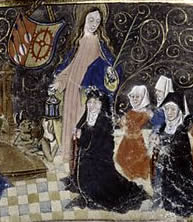Gudula facts for kids
Quick facts for kids Saint Gudula of Brabant |
|
|---|---|

From New York Public Library, MA 092, fol. 251, Haarlem Gradual of 1494, depiction of Saint Gudula bearing a lantern which the demon endeavors to extinguish
|
|
| Born | c. 646 Pagus of Brabant |
| Died | 680–714 Hamme |
| Venerated in | Roman Catholic Church, Orthodox Church |
| Major shrine | Eibingen & St. Michael and Gudula Cathedral |
| Feast | 8 January; 19 January in the diocese of Ghent |
| Attributes | depicted as a woman with lantern which the devil tries to blow out |
| Patronage | Brussels; single laywomen |
Saint Gudula was a holy woman who lived a long time ago, around the 7th and 8th centuries. She was born in a region called Brabant, which is now part of Belgium. We know about her life from a book written in the 11th century. This book says her parents were Witger, a duke, and Amalberga of Maubeuge.
Gudula's name is linked to several important places:
- Moorsel: This is where she lived.
- Brussels: A special church group was started here in her honor in 1047.
- Eibingen: A part of her skull, called a relic, is kept safe here.
In Brabant, people often call her Goedele or Goule. Her name can also be seen as Gudila or Gudula in Latin, Sinte Goedele in Dutch, and Sainte Gudule in French.
Contents
Her Early Life and Family
Gudula's mother, Saint Amalberga of Maubeuge, became a nun at the abbey of Maubeuge. She was given her veil (a special cloth worn by nuns) by Saint Aubert, who was a bishop. Gudula had two sisters, Saint Pharaildis and Saint Reineldis, and one brother, Saint Emebertus.
Gudula was taught at the abbey of Nivelles by her godmother, Gertrude of Nivelles. After Gertrude passed away, Gudula moved back to her family home in Moorsel. She spent her time doing good deeds and praying. She often walked about two miles from her house to visit the church in Moorsel.
Her Resting Place
Gudula died and was buried in a place called Hamme. Later, her relics (her remains) were moved to the church of St. Salvator in Moorsel. They were placed behind the altar.
Much later, between 977 and 992, her body was moved again. It was taken to Saint Gaugericus' chapel in Brussels. In 1047, a nobleman named Lambert II started a special group to honor Saint Gudula. Her relics were then moved to the church of Saint Michael in Brussels. This church later became the famous Cathedral of St. Michael and St. Gudula.
Sadly, in 1579, the church was attacked by a group called the Protestant Geuzen. They damaged the church and scattered the saint's relics.
Honoring Saint Gudula
Saint Gudula is very important in Brussels. She is one of the city's patron saints, along with Saint Michael. A patron saint is like a special protector.
- Her feast day, which celebrates her life, is usually on January 8th. This is believed to be the day she died.
- However, in the diocese of Ghent, where Moorsel is located, her feast day is on January 19th.
- Long ago, a powerful ruler named Charlemagne gave gifts to the convent in Moorsel to honor her.
There is a special flower called tremella deliquescens that grows in early January. People call it Sinte Goedele's lampken, which means "St. Gudula's lantern."
The skull of Saint Gudula is kept safe in a Catholic church in Eibingen, Germany.
What She Looks Like in Art
Saint Gudula is often shown holding a lantern. In old pictures, she might be holding a candle in one hand and a lamp in the other. A demon is often shown trying to blow out the flame.
This image comes from a famous story about her. The legend says that Gudula would go to church very early in the morning, before the rooster crowed. A demon wanted to stop her from doing good. So, the demon would blow out her candle. But, Gudula would pray, and God would make her lantern light up again! This shows her strong faith.
See also
 In Spanish: Gúdula para niños
In Spanish: Gúdula para niños
- Saint Gudula, patron saint archive
Images for kids
-
Statue of Saint Gudula in the Cathedral of St. Michael and St. Gudula, Brussels


